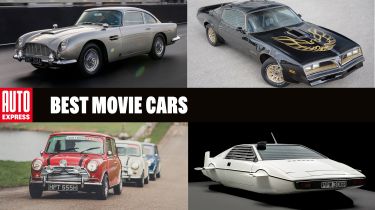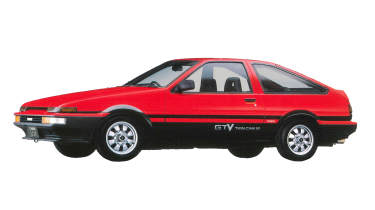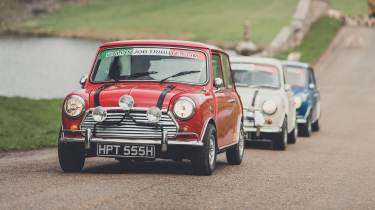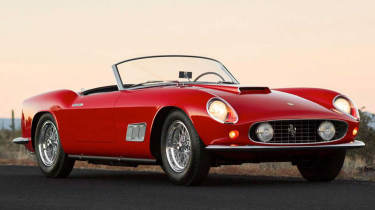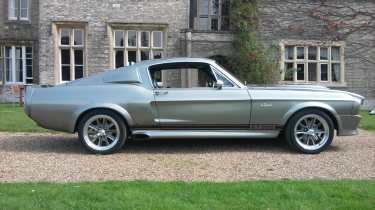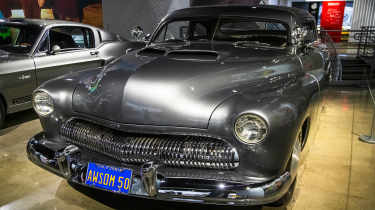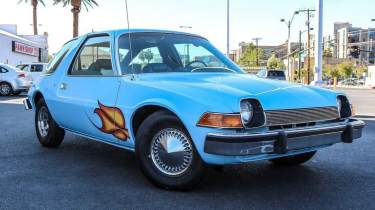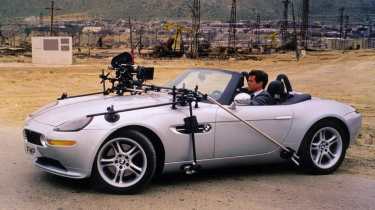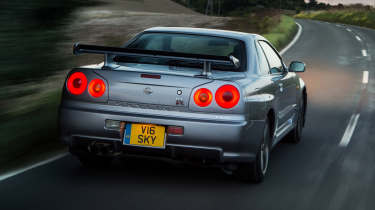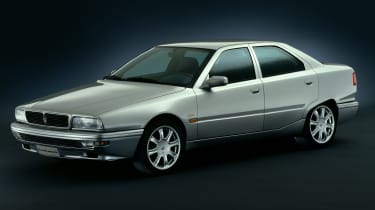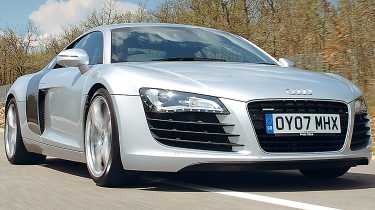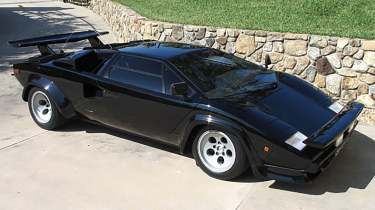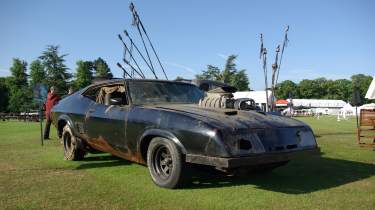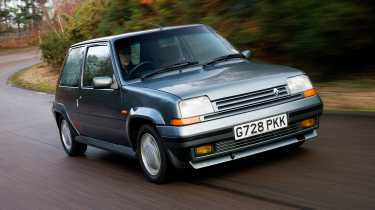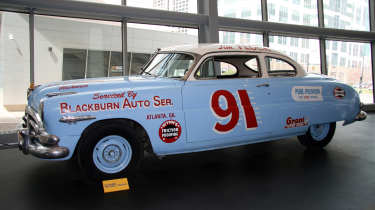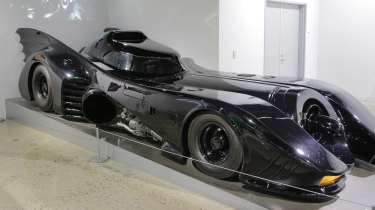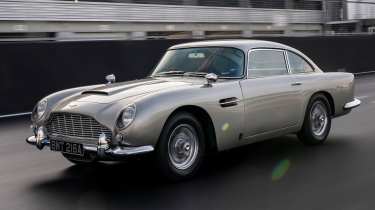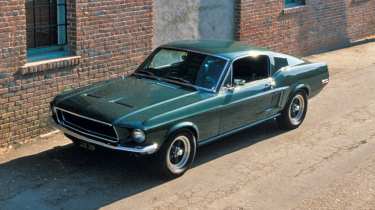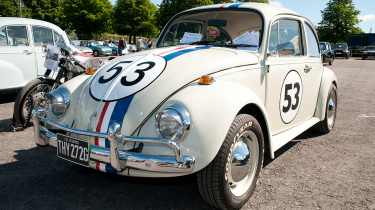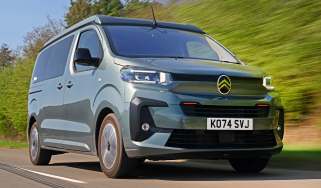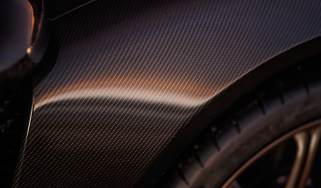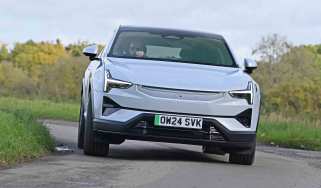Best cars from movies: our favourite movie cars to ever grace the silver screen
We take an in-depth look at the automotive stars of the silver screen, taking in some of the most iconic movie cars
Cars of all shapes and sizes have played pivotal roles in all kinds of movies. They can be real cars drafted in to play a part, like the Ford Mustang from Bullitt or the Mini Coopers in The Italian Job, or a fictional creation like Chitty Chitty Bang Bang. But of all of the classic and memorable cars in movies throughout the ages, which movie car is the best ever? We asked you, the Auto Express reader, and you voted in your droves.
As car fans, we can't deny that we tend to focus on the cars in any movie we watch. With another James Bond film on the horizon, finding out what 007’s wheels will be is just as important as the plot (for petrolheads at least). On the silver screen, cars have the potential to transcend the sum of their parts and become legends even if they're a bit naff in real life. That applies whether the car is simply used as a tool to get from A to B, as a hero's wheels in a thrill-a-minute car chase or as a gadget-laden time machine on wheels.
This all means that everyone has an opinion on what makes a great movie car. When we asked Auto Express staff for their opinion, everyone had their say. So what are the best movie cars of all time? Check out our list right here...
The Transporter - BMW 7 Series (E38)
- Price new: £7,000 (est)
- Price now: £15,000
- Powertrain: 3.5-litre 8cyl petrol; six-speed manual gearbox
- Power: 235bhp
- 0-62/top speed: 0-60mph in 7.5 secs/152mph
Around the millennium, movie-goers were treated to some stunning car chases that really focused on the cars themselves rather than the characters behind the wheel. We had Taxi (the 1998 French film, definitely not the 2004 one with Jimmy Fallon), The Bourne Identity and something that could’ve easily made this list, Ronin. With some rather absurdly unbelievable elements, The Transporter isn’t a great film by any means, but it does have a great car chase right at the beginning to suck us car bores in. The getaway car is a BMW 7 Series of the E38 generation. Black and in 735i trim with some aftermarket alloys it looked incredibly ominous on the streets of Nice, even if the big BMW’s softly sprung suspension made a visible meal of some tight corners.
Some eagle-eyed viewers would probably notice the 7 Series’ strange ability to regenerate an offside wing mirror from one scene to the next and at certain points the V8 sounds like a wailing motorbike engine, but as an impressionable young boy I was more drawn to the classic lines of BMW’s flagship of the nineties.
Barely a quarter into the film, however, the ‘hero car’ gets blown up by the bad guys, and while a rather lovely W140 Mercedes S-Class makes a brief appearance, nothing quite captures the imagination like the opening scenes with that 735i.
Initial D - Toyota AE86 Trueno
- Price new: £8,799
- Price now: £30,000
- Powertrain: 1.6-litre 4cyl petrol; five-speed manual gearbox
- Power: 123bhp
- 0-62/top speed: 0-60 in 8.3 secs/122mph
An icon of Japanese motoring, the Toyota AE86 Trueno made waves not just in motorsport, but film and TV as well. The AE86 demonstrated that despite only having a 1.6-litre four-cylinder with 123bhp, it could take on the world’s mightiest sports cars of the eighties, because it won Drivers’ and Manufacturers’ titles in the European and British Touring Car Championships. The AE86 then earned a new fanbase in the nineties, thanks to the hit anime show, Initial D, which followed the late night street racing heroics of a teenage tofu delivery driver. As with its motorsport heritage, the TV series and latterly a live-action film (which flopped), showed the AE86 taking on much more powerful sports cars, with the Toyota’s nimble rear-wheel drive chassis, high-revving double overhead-cam engine and low weight all aiding it to victory – alongside the main character’s hilariously incredible driving skill.
The impact Initial D had on a certain segment of car enthusiasts caused the values of Toyota AE86 to skyrocket, with the hatchback ‘Trueno’ with pop-up headlights the one to get – preferably in the same black and white two-tone paint finish as the hero car. If you want to get really nerdy you can plaster the name of the main character’s tofu shop on the side, too. Toyota hasn’t forgotten its legendary AE86 either, with the GT86 and GR86 names paying homage to their distant predecessor.
The Italian Job - 1967 Mini Cooper S
- Price new: £756
- Price now: from £16,000
- Powertrain: 1.275-litre 4cyl petrol; four-speed manual gearbox
- Power: 75bhp
- 0-62/top speed: 0-60 in 11 secs/97mph
There have been plenty of cars which have left a cultural imprint on both film and car lovers alike, but there are few models which replicated the success of the Austin Mini Cooper S. Fresh off the back of its Monte Carlo Rally wins in 1964, ’65 and ’67, the Mini Cooper S then went on to feature in The Italian Job in 1969.
Used as a tool to undertake an enormous gold heist in Turin, the red, white and blue Mini Cooper S’ were able to show off their high levels of practicality and agility as the cars were wheeled though tight Italian streets, shopping arcades and even sewers to escape the police – essentially demonstrating the same qualities which made the Cooper S successful on the rally circuit.
The fast-paced car chase and nimbleness of the Mini only increased the level of cool attached to the production models.
Eagle-eyed car nuts will probably notice that the Minis used in The Italian Job are on G-suffix registration plates, indicating that the cars were registered in 1969 – the film’s intended year of release. However, the cars used weren’t from 1969, but actually from 1967 on future-dated reg plates. This was because the British Motor Corporation was preparing to launch the Mk2 Mini just before the film's public release and thus any 1969 Minis would have been the newer Mk2’s.
The success of the Mini really showed no signs of slowing down at any point in the sixties. Not only did the Mini become the ultimate fashion icon or accessory, thanks to celebrities of the day, the dinky model regularly showed up bigger, more powerful cars on the Touring Car circuits. The production model was also a hit with families, thanks to its clever design which helped optimise cabin space with its transversely mounted engine. The Mini was also relatively cheap to buy, cheap to run and simple to repair, too.
Smokey and the Bandit - 1977 Pontiac Trans Am
- Price new: around £5,500 in 1977
- Price now: from £50,000
- Powertrain: 6.6-litre 8cyl petrol; four-speed automatic gearbox
- Power: 200bhp
- 0-62/top speed: 0-60 in 7.7 secs/149mph
The Pontiac Trans Am has become somewhat a common car on the silver-screen, with stars such as Steve McQueen and John Wayne getting behind the wheel over the years. But mention the Trans Am to any car or film buff and you’ll almost certainly talk about Burt Reynolds and the 1977 blockbuster Smokey and the Bandit.
Of course, the ‘screaming-chicken’ decaled Starlight black paint and gold striped Trans Am driven by Bandit (Reynolds) wasn’t exactly your standard Trans Am, but rather a mix of cars. At a glance, the car used in the film looks like a 1977 Trans Am, but this model-year hadn’t entered production yet, so the cars used in filming are 1976 models with styling tweaks made to look like the upcoming new car. Pontiac had agreed to give the film crew four cars for free, which paid off spectacularly as the model sold like hot cakes after the film's release, with the manufacturer even delaying production of the third-generation car.
While the Pontiac Trans Am was the real star of the film, its real-world performance credentials weren’t exactly ground-breaking, and if you were planning on using a 1976/77 Trans Am as bait car to bootleg booze across state lines, you’ll probably want a bit of a headstart.
The Pontiac LeMans used by the police in the film might have had a similar power output, but thanks to some uprated front and rear springs, stronger brakes and some tinkering under the bonnet, the LeMans could be driven harder than the Trans Am. it probably didn’t help that the LeMans was actually offered by Pontiac to police departments across the United States. Still, we wouldn’t blame you if you wanted a Trans Am anyway.
Ferris Bueller’s Day Off - Ferrari/250 GT California Spider
- Price when new: £5,500 (1961)
- Price now: £10-20million-plus
- Powertrain: 3.0-litre V12 petrol; four-speed manual
- Power: 276bhp
- 0-62mph/top speed: 0-60mph in approximately 6.0 seconds/150mph
The Ferrari 250 GT California Spider in Ferris Bueller’s Day Off isn’t just a movie car – it’s a rolling dream. A 3.0-litre V12, triple Weber carburettors and Pininfarina styling make it one of the most beautiful and sought-after Ferraris ever. Except, of course, the film didn’t use a real one. Instead, it was a Modena GT Spyder California, a replica designed to look the part without sacrificing a priceless classic. But that doesn’t make its on-screen destruction any less painful. Seeing it plummet through a glass window is like watching automotive sacrilege. It’s the ultimate fantasy machine, because it’s fast, rare, effortlessly breathtaking and absurdly expensive, which is exactly why it remains one of the most unforgettable movie cars of all time.
Ferrari built just 106 examples of the 250 GT California Spider, split between short and long-wheelbase versions. Today, they’re among the most valuable classic cars on the planet, with pristine examples fetching well in excess of £10million. Given that price tag, Ferris Bueller’s Day Off was never going to risk a real one, because smashing up a genuine 250 GT would have been unthinkable.
That didn’t stop the Modena GT Spyder from becoming a star in its own right, though. Thanks to its silver-screen fame, these replicas are now highly sought after, commanding serious money in their own right. Even now, no other film captures the idea of an untouchable dream car meeting such a painful fate quite like this one.
Gone in 60 Seconds (remake) - Shelby GT500 “Eleanor”
- Price when new: £2,000 (1967)
- Price now: £200,000-£1million-plus
- Powertrain: 5.8-litre V8 petrol; five-speed manual
- Power: 355bhp
- 0-62mph/top speed: 0-60mph in approximately 6.5 seconds/125mph
Few movie cars have the presence of Eleanor, the Shelby GT500 from Gone in 60 Seconds. Long, low and dripping with aggression, it looks as mean as it sounds. Under the bonnet, a snarling 5.8-litre V8 growls like a wolf gearing up for the hunt, delivering enough power to break traction at will. But Eleanor isn’t just about speed, it’s also a wild animal, constantly fighting the driver, demanding skill and respect. The custom bodywork, with flared wheelarches, a low front bumper and side-exit exhausts, gives it a menacing stance, while the way it moves – drifting, jumping and clawing at the tarmac – cements its legend. Plenty of Mustangs have hit the big screen, but none have felt as alive as this.
Unlike the original 1974 film, which featured a yellow Mustang Mach 1, the 2000 remake turned Eleanor into something far more menacing. Designed by Chip Foose, the GT500 tribute car was given an instantly recognisable silhouette, with a bespoke bonnet scoop and the now-iconic silver-and-black paint scheme. The look was so successful that it inspired countless replicas, some selling for six-figure sums.
Its on-screen legacy is undeniable. The final chase sequence, when it outran helicopters, dodges police and nails the now-famous ‘Eleanor jump’ over a jammed bridge, turned the car into a cult hero. The hype was so intense that a legal battle even erupted over the Eleanor name – proof of just how much impact this Mustang had.
Cobra - 1950 Mercury ‘lead sled’
- Price new (1950): $2,150
- Price now: $75-100,000 (est)
- Powertrain: 5.7-litre 8 cyl petrol; three-speed auto gearbox
- Power: 600bhp
- 0-62/top speed: n/a
While the combined star quality of Sly Stallone and his then-wife Brigitte Neilsen don’t make gritty eighties LA cop thriller Cobra a must-watch, the movie should definitely be on the watch list for fans of classic American custom car genres. Stallone’s character Marion ‘Cobra’ Cobretti, for no immediately plausible reason, tools around his patch at the wheel of a sweet-looking and gnarly-sounding fifties’ Mercury coupé ‘lead sled’, complete with roof-chop, dechromed and battleship grey primer-style body, plus smooth ‘Moon disc’ hub caps.
Not so smooth is the supercharged and nitrous-oxide injected Chevrolet V8 engine making a reputed 600bhp, which replaced the stock Ford ‘flathead’ V8, or the muscle-car style bonnet scoop that upset some lead-sled enthusiasts as being distinctly not part of the period custom look.
There were four versions of the movie car built for Cobra at the behest of the producers, of which one was destroyed in the film – sadly fairly early on, after which the plot does drag a little. One of the others ended up in Stallone’s personal collection. It was stolen from him in 1994, but returned in 2017 when it turned up for auction and was recognised.
Wayne’s World - 1976 AMC Pacer
- Price new (approx): $3,500
- Price now (2022 auction): $71,500
- Powertrain: 4.2-litre 6cyl petrol; three-speed auto gearbox
- Power: 100bhp
- 0-62/top speed: n/a
The 1991 movie Wayne’s World was brilliantly stupid, and while it’s harsh to suggest the same epithet might be applied to the 1976 AMC Pacer that starred alongside anti-heroes Wayne and Garth as ‘The Mirthmobile’, there’s a case that could be argued.
The roots of the unusually-styled Pacer, named the ‘flying fishbowl’ by one contemporary reviewer, were in the seventies and predated that decade’s oil crisis. Nonetheless, AMC product planners predicted increasing demand for smaller, more efficient cars, and came up with a seemingly revolutionary format: a car with as much passenger space as a full-size American sedan of the time, but with a much smaller footprint. Sadly, a limited parts bin at AMC meant the Pacer came with a 4.2-litre straight-six giving 19mpg, instead of a more frugal option.
Excessive weight due to its wide body and the unusually extensive glazing, a severely limited boot and the arrival of more efficient rivals meant the Pacer never really took off at home in the US or abroad. Yet many of its design goals, particularly the requirement to maximise interior space while limiting the footprint, would soon become design fundamentals. The roof-mounted liquorice dispenser featured on the Wayne’s World car was not one of them.
James Bond, The World Is Not Enough - BMW Z8
- Price new: £86,650
- Price now: from £190,000
- Powertrain: 4.9-litre V8 petrol; six-speed manual gearbox
- Power: 395bhp
- 0-62/top speed: 0-60 in 4.7 secs/155mph
Largely unloved back in the day, the BMW Z8 now has something of a cult following – and not least because it featured in the hallowed James Bond franchise. Fine, so Pierce Brosnan’s drop-top from The World Is Not Enough may have met its demise being cut in two by a giant circular saw, but to my eyes, even half a Z8 is better than no Z8.
The brawny BMW’s beauty is more than skin deep, of course, because under the bonnet sits the 395bhp 4.9-litre petrol V8 from the E39-generation M5. Power is sent to the rear wheels via a six-speed manual gearbox, and 0-62mph takes just 4.7 seconds. Imagine cruising down to the French Riviera in one of these – it simply doesn’t get any better.
The Z8’s cabin is a bit busy – a throwback to an era of quirky, screen-free cabins – and it was unfortunately never built for right-hand drive. But with the roof down and the wind in your hair, you’re not likely to notice. If you’ve got a spare £200,000 lying around, there’s no better way to live out your wildest Hollywood hallucinations.
2 Fast 2 Furious - Nissan Skyline R34 GTR
- Price new: £54,000
- Price now: from £90,000
- Powertrain: 2.6-litre 6cyl turbo petrol; six-speed manual gearbox
- Power: 276bhp
- 0-62/top speed: 0-60 in 4.7 secs/165mph
Given I’m now in my late-thirties, the nineties and early-noughties were formative in cementing my love for all things automotive. When I wasn’t studying for school exams, my head would be buried in magazines such as Auto Express, or glued to PlayStation games like Gran Turismo. Then the Fast & Furious franchise came along, and turned everything I knew on its head.
This world of tuner cars fascinated me; mainstream models – Honda Civics and Volkswagen Jettas – turned into Ferrari-baiting super saloons. But while the late Paul Walker’s Toyota Supra from the first film was cool, it couldn’t hold a candle to the R34-generation Nissan Skyline GTR from the 2 Fast 2 Furious sequel. I can still hear the turbo flutter and induction noise when I close my eyes today.
I’m clearly not the only one who’s heart it stole; clean examples now trade hands for more than £100k. I’ll take mine without the wide bodykit or racing stripes; a stock Skyline is about as cool as it gets – especially in that iconic shade of blue. But the performance potential is huge; it’s not uncommon for owners to extract more than 1,000bhp from the turbocharged straight-six, through a blend of high-end parts and ECU tunes. They’re also quite likely to go bang if you don’t take care of them – and I expect finding a good one is harder now than it’s ever been before.
Baby Driver - Subaru Impreza WRX
- Price new: £28,330
- Price now: £5,000
- Powertrain: 2.5-litre flat-four petrol; five-speed manual gearbox
- Power: 276bhp
- 0-62/top speed: 0-60 in 5.2 secs/158mph
In the sometimes dark, sometimes funny action thriller that is Baby Driver, its main character Miles – or Baby as he refers to himself as – arguably plays second fiddle to his co-star in action: a 2007 ‘Hawkeye’ Subaru Impreza WRX.
Baby, who suffers from tinnitus, finds comfort by listening to music on his earphones while driving the iconic red WRX as a getaway driver for hire. This gives him some disconnect from both the police he’s trying to evade, and the criminals sitting in the back seats.
The clever bit is that, if you actually think about it, there’s probably no better getaway car than a Subaru WRX. Its four-door cabin is spacious, but the car itself is not too big or heavy. It has a traction advantage over police vehicles, thanks to an all-wheel-drive system, plus a boosted flat-four engine that makes it extremely fast point-to-point.
It’s not the most glamorous or exciting car to look at, but then this is largely the point. If you were to think about what really makes a good getaway car, or ruminate about an alternate reality in which you were trying to evade the LAPD, I honestly can’t think of a more suitable steed. I even like the fact that it’s red and has a couple of subtle modifications that help it blend into the LA roadscape.
Die Another Day - Maserati Quattroporte IV
- Price new: £58,000
- Price now: £15,000
- Powertrain: 3.2-litre twin-turbo V8 petrol; five-speed manual gearbox
- Power: 330bhp
- 0-62/top speed: 0-60 in 5 secs/170mph
It’s not uncommon for the villain's car in a Bond film to be Italian, but we’d guess that the rare and rather unloved (by some) Quattroporte IV might just be the most subtle and sophisticated pieces of automotive casting across the series. This unusually styled four-door was the last mass-produced car designed by Marcello Gandini, but it was underpinned by a challenging set of proportions that even he couldn’t hide.
Yet while the exterior’s frumpy looks might not suggest so, the 3.2-litre twin-turbocharged V8 that was fitted under the bonnet of these later Evoluzione models did make it a 170mph car; it even had a manual transmission. In real life, however, the chase would probably not have lasted quite so long as the QP IV does have a flakey reputation, one that makes sixties British cars seem hewn from stone.
The real conundrum for us, though, is that this last-generation Evoluzione model was so rare that the filming, and therefore destruction, of more than one example probably did some serious damage to the remaining stock. As an avid lover of these boxy-looking numbers, it pains me to ponder the scale of destruction that has occurred. Just don’t think about it Jordan, just don’t think about it.
Back to the Future - 1981 DeLorean DMC-12
- Price new: £16,660
- Price now: £65,000
- Powertrain: 2.8-litre V6 petrol; five-speed manual gearbox
- Power: 130bhp
- 0-62/top speed: 0-60 in 10.5 secs/130mph
The way I see it, if you're gonna build a time machine into a car, why not do it with some style? Not my words, but the words of Dr Emmett Brown, yet frankly it’s hard to argue with them. It’s even harder to imagine the iconic Back to the Future trilogy without the DeLorean DMC-12 in its starring role, which actually almost didn’t happen, because early drafts for the first film featured a fridge as the time machine.
The car already had sci-fi looks with its wedge-shaped, stainless steel bodywork and gullwing doors, with the film’s designers adding a mess of parts to the rear deck, plus the flux capacitor and endless wires inside, to make it look like a mad science project. Of course, by the time the DeLorean was immortalised on the silver screen by Robert Zemeckis in 1985, production had ended and DeLorean Motor Company had filed for bankruptcy.
The DeLorean probably has the aerodynamic qualities of a fridge to be honest, and didn’t handle much better than one either. The tense moments in the film where Marty McFly gradually edges closer to 88mph also become much more realistic when you learn that this exotic-looking sports car is powered by a 130bhp 2.8-litre V6 developed by Renault, Peugeot and Volvo that’s good for 0-62mph in 10.5 seconds, at least according to the people who made it.
Iron Man - 2008 Audi R8 V8
- Price new: £78,195
- Price now: £30,000-£40,000
- Powertrain: 4.2-litre V8 petrol; six-speed automated manual gearbox
- Power: 414bhp
- 0-62/top speed: 0-60 in 4.4 secs/187mph
When the first Iron Man film was released in cinemas, I was only eight years old and had absolutely no clue about cars. But as soon as I saw genius, billionaire, playboy, philanthropist Tony Stark slicing through traffic and going flat out in his outrageously sexy, metallic silver Audi R8, I knew this was obviously the coolest car in the world.
It’s only featured in the film for a few brief moments, but one shot takes full advantage of the glass engine cover allowing audiences to savour the mid-mounted 4.2-litre V8, spitting out 414bhp and a bassy exhaust note. Early R8s like this were available with a six-speed, gated manual transmission, however, seeing as Tony Stark’s whole life revolves around advanced technology, he’d probably have opted for the automated R-Tronic unit.
Following its breakout role, the Audi R8 not only earned a special place in my heart, but became known the world over as Iron Man’s car. It was also the first of many of the German brand’s cars to appear across the Marvel Cinematic Universe. Every installment in the Iron Man trilogy includes an R8 of course, including an all-electric one in the final film, while the Audi e-tron GT and Audi e-tron Sportback concepts are featured in Avengers: Endgame – for a time, the highest grossing film ever.
The Cannonball Run - Lamborghini Countach LP 400 S
- Price new: £80,000
- Price now: £800,000
- Powertrain: 4.0-litre V12 cyl petrol; five-speed manual gearbox
- Power: 375bhp
- 0-62/top speed: 0-60 in 5.4 secs
The Cannonball Run is a right of passage for car lovers, as long as you don’t take any of the film’s silliness too seriously. And the opening sequence of nearly four minutes of Countach is up with the best - a beautiful car (if you ignore the front spoiler that for some reason found its way on for the movie) let loose on an empty highway in the American sunshine, as the black Lamborghini is fruitlessly chased by a Pontic police car. The engine note booms underneath Ray Steven’s theme song as an unmatched array of box office superstar names roll through the opening credits. But it’s a car movie, and the Countach is the biggest star.
From Burt Reynold’s ambulance and Jackie Chan’s tech-loaded Subaru to Roger Moore’s Aston Martin DB5 (which rings a bell from somewhere else…) and the Ferrari 308 driven by fake priests Dean Martin and Sammy Davis Jr, with a varied supporting cast including Rolls-Royce Silver Shadow, GMC pick-up and decal-heavy Chevrolet Impala, the cars keep coming, but the Countach is the star of the opening sequence, and the stand-out set of wheels throughout.
Yes the spoiler and the 12 (yes, twelve) exhaust pipes were a little unnecessary, but the most 80s of 1980s supercars deserved a starring role, and owned the stage in a way no other car of the era could have done.
The Spy Who Loved Me - Lotus Esprit S1
- Price new: £7,995
- Price now: £60,000, or £550,000 in submarine spec
- Powertrain: 2.0-litre 4cyl petrol; five-speed manual gearbox
- Power: 160bhp
- 0-62/top speed: 0-60 in 6.8 secs/138mph
Putting your faith in the reliability of a 1970s Lotus to escape bad guys when it’s raining might seem optimistic, but Roger Moore’s James Bond did much more than when he evaded a machine gun-toting helicopter by driving his Esprit off a pier. Luckily, he had ticked the options box for a fully working and fully armed submarine, which sees off a couple of torpedo-clad divers and an actual mini-submarine before emerging onto a Sardinian beach and handing an astounded tourist a fish before cruising off.
Perry Oceanographic in Florida constructed what became known as Wet Nelly, the custom-built operational submarine version of the Esprit that was bought at auction by none other than Elon Musk in 2013.
A total of seven Esprit shells were used for filming the various elements of the submarine sequence, only one of which was the fully motorised submarine. In the film it’s armed with a sea-to-air missile launcher that takes care of the helicopter, front-mounted torpedos, ink jets, mine launcher and periscope, as well as cement sprayers for use on land. All deployed with Bond’s usual suave one-liners.
But it’s the indelible scene where Bond and KGB agent Anya Amasova appear out of the sea and motor up the beach that has cemented the Esprit in cinematic history.
Mad Max - 1973 Ford Falcon XB GT
- Price new: £5,500
- Price now: £200,000
- Powertrain: 5.8-litre V8 petrol; four-speed manual gearbox
- Power: 300bhp
- 0-62/top speed: 6.3 secs/132mph
While the Ford Falcon XB GT Hardtop was revered in Australia as one of the country’s greatest muscle cars, the big two-door coupe achieved global stardom when it was painted black, given a ‘droop snoot’ front end, a fake blower and was rechristened The Last of the V8 Interceptors. It was used by Mel Gibson’s tough cop ’Mad’ Max Rockatansky to exact revenge on a roaming killer biker gang in the dystopian Aussie outback, and its home-built look fitted perfectly with the movie’s aesthetic alongside a number of other unique creations. It came back for Mad Max 2, and also had brief cameos in the two recent Mad Max productions, while the original car now has a permanent home in Miami.
The Falcon didn’t achieve movie immortality immediately, though. Once filming had finished, the production team gave away its star car to one of the crew in lieu of payment for their services, and they used it as a promotional tool while looking for a buyer. When Warner Bros. came calling looking for the car in preparation for 1981’s Mad Max 2, the car was dusted off and pressed into service once more, but even after a second appearance it was discarded once more, this time to be scrapped. Fortunately it was saved from the crusher, and eventually a fan of the franchise got their hands on the Last of the V8 Interceptors and restored it to its former glory.
Ali G Indahouse - Renault 5 GT Turbo
- Price new: £50,000 (est)
- Price now: £6,000
- Powertrain: 1.4-litre four-cylinder turbocharged petrol; five-speed manual gearbox
- Power: 120bhp
- 0-60/top speed: 7.6 secs/120mph
Yellow Renault 5s are all the rage at the moment, but it was back in 2002 when this luminous supermini truly rose to fame. Admittedly, the humour of Ali G Indahouse isn’t to everyone’s tastes, but few can truly resist the Max Power-eqsue charm of this ridiculously overmodified car. Multiple subwoofers, twin rear spoilers, colour-matched alloy wheels and blue bucket seats; these are just some of the wild features that transformed this mainstream motor into a movie icon.
Of course, the 5 in question is the 5 GT Turbo, so it wasn’t without its fair share of madness before it was modified. It’s not exactly blistering by modern hot hatch standards, but its turbocharged four-cylinder was good for 120bhp and a 0-60mph time of 7.6 seconds in factory spec. Bear in mind that this car weighs less than a tonne and you’ll soon understand the appeal.
As part of the ongoing battle between the west side and east side, the movie also features a rival Renault 5 that’s perhaps even more distinctive thanks to its silver paintjob, twin exhausts in place of the rear number plate, and custom digital dash. So which side (and car) is best? The only way to decide is a nail-biting and speed-limit conscious drag race through the streets of Staines.
Cars - Hudson Hornet
- Price new: £2,500 (est)
- Price now: £39,000
- Powertrain: 5.0-litre six-cylinder petrol; five-speed manual gearbox
- Power: 143bhp
- 0-60/top speed: 0-60mph in 14.6 secs/97mph
Yes, ‘Doc’ Hudson is an animated Pixar character, but he’s based on a very real car: the Hudson Hornet. This giant yet swooping machine has exactly the kind of dimensions and styling that you’d only find in post-war America, and it was available in two-door, four-door or convertible form. It’s arguably the two-door that’s the most iconic, though, as it was these models that accelerated this car to fame within the motorsport world.
It was thanks to a series of NASCAR races that the now infamous moniker ‘Fabulous Hudson Hornet’ was born. Even though it was only powered by a straight-six, the Hornet managed to see off plenty of V8-powered rivals in the early 1950s. Today, thanks to the magic that is animation, a whole new generation has now taken interest in this all-American icon.
Batman & Batman Returns - Batmobile
- Price new: £1milllion (est)
- Price now: £1.5million
- Powertrain: Jet turbine with afterburner; automatic gearbox
- Power: 10,000bhp
- 0-62/top speed: 0-60 in 3.7 secs/330mph
When the time came to create a new Batmobile for the big screen, the dark Art Deco look favoured by director Tim Burton meant there was no place for the classic Lincoln Futura concept-based Batmobile of the 1960s. So the special effects team at Pinewood Studios in the UK created a Batmobile for a new generation. At 6.6 metres long and 2.4 metres wide, the Batmobile was certainly imposing, while a gas turbine engine necessitated the gaping air intake up front and the flame-spitting exhaust.
A superhero car delivered superhero stats, too, with a claimed 10,000bhp (with afterburner) and a 330mph top speed, while rolling bombs, twin machine guns and an under-floor ‘foot’ that helped the Batmobile turn through 180 degrees on the spot all featured. And then there’s the pop-up shield system that fully enclosed the car when parked.
Of course, this was all pure movie fantasy, with the real Batmobile (of which two were built for the 1989 movie, then three more for Batman Returns) based on a Chevy Impala chassis and with a conventional V8 under the bonnet for set pieces. All of the movie cars are still in existence in private collections, while plenty of replicas have been built, too, including one actually powered by a gas turbine engine, although whether it has a 330mph top speed is unverified.
James Bond: Goldfinger - Aston Martin DB5
What else could top this list? The Aston Martin DB5 is quite possibly the most famous car in history, thanks to its starring role in one of the best Bond movies of all time – Goldfinger.
Bond’s DB5 had everything: drop-dead gorgeous looks, speed and enough gadgets to get 007 out of any tricky situation. The DB5 was equipped with an ejector seat, front mounted machine guns, a bulletproof screen, tyre shredders, a GPS tracker, an oil slick… and we could go on.
The car’s iconic nature meant that it reappeared for cameos in other Bond movies; after a long absence of around 30 years, the DB5 briefly appeared in GoldenEye and Tomorrow Never Dies. Among the more memorable moments in recent Bond films was the time Daniel Craig’s 007 used the car to escape Silva in Skyfall, and employed the car’s front-mounted machine guns to defend Skyfall Lodge.
Rockstar Games even parodied the Bond car in Grand Theft Auto V. The in-game car is called the Dewbauchee JB700, and is the focus of a mission in the main storyline. The player uses the car's in-built machine guns, spike deployment and ejector seat to evade the police.
Bullitt - Ford Mustang GT Fastback
Known as a film with one of the most iconic car chases ever, Bullitt starred Steve McQueen, driving an olive green Ford Mustang GT Fastback that has made muscle car fans go weak at the knees for decades.
McQueen was a keen driver, and took part in a significant amount of the chase scenes himself, where his Mustang and the Dodge Charger blasted through downtown San Francisco, getting airborne over many of the cities’ steep hills.
The Mustang(s) used for filming were heavily modified to take on the fast-paced stunt work, but witnesses claimed that the assassins’ Dodge Charger needed little in the way of changes to cope with the stresses of the chase.
Although the Ford Mustang wasn’t the first muscle car to exist, it was the first one to get the recipe just right. The first generation had a punchy engine, it was easy to build and repair (thanks to the robust parts used) and looked the business, too. Plus, all of that was coupled with a relatively cheap starting price of around $2,300 in 1964, which calculates to roughly $18,000 (£12,000) in today’s money.
Since then, the Mustang has become a classic name that has lived on for more than 50 years. It’s taken all of that time for the UK to get a right-hand drive model, so naturally there’s already a 12-month waiting list for one.
Herbie, The Love Bug - Volkswagen Beetle
As the only car on this list that has a mind of its own, the affectionately named Herbie stole millions of hearts when it was first seen on screens in 1968. Not only does it have a mischievous personality, but it’s loyal, competitive and stubborn, too.
Finished in cream, with red, white and blue racing stripes, Herbie wins countless races, helps to stop a widow’s house from being demolished and it even falls in love with a Lancia Montecarlo. We last saw the love bug when Lindsay Lohan starred in Herbie: Fully Loaded – a reboot funded by Disney.
The VW Beetle, known as the Käfer in Germany, is one of the few cars in the world that almost anyone can recognise. The original design hardly changed from its inception when a certain dictator wanted to create a “people’s car” for his country, up until the very last Beetle rolled off the Mexico production line in 2003.
The car had a particular boom during the sixties, as it, along with the VW Camper, became symbols of the ‘hippie’ movement. The Beetle is still used today as a taxi in Latin America, where you can find a huge number of wildly painted examples roaming the streets of Mexico City. Volkswagen has since revived the Beetle name, in order to keep the spirit alive and modern versions adhere to the basic shape of the original.
Chitty Chitty Bang Bang - Chitty Chitty Bang Bang
Not only does Chitty Chitty Bang Bang look brilliant, but it also (spoiler alert!) flies! Named after the noises it makes when it coughs and splutters into life, the eponymous car spawned countless replicas over the years, one of which was famously owned by Chris Evans.
Chitty Chitty Bang Bang has the look of classic cars from the 1920’s, with Dick Van Dyke’s character Caractacus Potts rebuilding it using an old boat hull and even metal parts from a chimney to cover the engine.
Since it was a mish-mash of parts, it’s hard to nail down exactly what model of car Chitty Chitty Bang Bang was derived from. However, we do know that the musical film had six CCBB’s made, one of which was road legal and registered in the UK.
That car used a Ford Essex V6 that was built at the Dagenham plant and featured in the Ford Transit van of the same era. Also, Dick Van Dyke said that the car was difficult to manoeuvre and had “the turning circle of a battleship.”
When a stage show of Chitty Chitty Bang Bang came to London in 2002, the car built for it took the world record for the most expensive prop ever built for a theatre show.
Ghostbusters - Cadillac Miller-Meteor Ambulance
When we first saw the Cadillac Miller-Meteor ambulance/hearse cross in Ghostbusters, it was a rusty black wreck of a thing. However, after Ray did extensive repairs on it, it gained the nickname ‘Ecto 1’ and became a symbol of the Ghostbusters crew.
Capable of carrying all of the kit Ghostbusters Peter, Ray, Egon and Winston needed to do their job properly, Ecto 1 is one of the most memorable components of the Ghostbusters movies.
Miller-Meteor was a coachbuilding firm set up in the 1950’s in the US, specifically to build and modify ‘professional vehicles’. It specialised in Cadillac, building cars like the ambulance and hearse models based on the Cadillac de Ville and Eldorado series cars. Not many ambulance models were actually built, as laws in the US came into force in the early 1970’s that restricted passenger cars being used as emergency medical vehicles.
Although Ecto-1 was based on the Cadillac ‘professional chassis’, the car had clear design cues from the wild finned Caddy passenger cars like the Eldorado. The bulging chrome foglamps, long creased bonnet and concealed rear wheels gave the Eldorado (and Ecto 1) an iconic design and one of the most memorable shapes in motoring history. The shape and design of the car never changed throughout the Ghostbusters franchise, although the upcoming all-female reboot of Ghostbusters uses a newer Cadillac Brougham hearse as Ecto-1 instead.
Our dealer network has 1,000s of great value new cars in stock and available now right across the UK. Find your new car…

